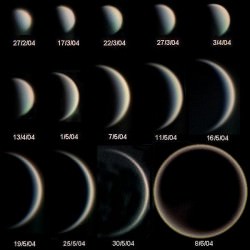What is it called when the lighted portion of the Moon appears to get larger?
Everyone knows that the Moon goes through phases, but let's talk almost why information technology does. It comes down to illumination, which in this case, all originates from our nearby star.
Our Moon orbits around our planet, and this Earth-Moon arrangement orbits around the Sun.
Even though nosotros only encounter light on part of the Moon, from the perspective of the Dominicus, half of information technology is always illuminated.
Stuck here on Earth, nosotros see the Moon in various phases of illumination equally it completes a 27.3 day orbit around the Globe.
Every bit The Moon travels around us we run across it pass through its phases. Information technology goes from New Moon, to Full Moon and dorsum to new Moon once more.
Crescent Moons are when it's less than half illuminated, and gibbous when information technology's more than half.
"Waxing" ways that the Moon becomes more illuminated night-by-night, and the term "waning" ways that it's getting less illuminated each nighttime.
- New Moon – When the illuminated side of the Moon is away from the World. The Moon and the Sun are lined up on the same side of the World, so nosotros can only see the shadowed side. This is also the time that you tin can experience solar eclipses, when the Moon passes straight in front of the Sun and casts a shadow onto the surface of the Earth. During a new moon, we tin can too see the reflected light from the World, since no sunlight is falling on the Moon – this is known as earthshine.
- Crescent – The crescent moon is the commencement sliver of the Moon that nosotros tin run across. From the northern hemisphere, the crescent moon has the illuminated border of the Moon on the correct. This state of affairs is reversed for the southern hemisphere.
- Get-go Quarter – Although it's called a quarter moon, we actually see this phase when the Moon is half illuminated. This means that the Sun and the Moon make a 90-degree bending compared to the World.
- Waxing Gibbous – This stage of the Moon occurs when the Moon is more illuminated that one-half, but it's not yet a full Moon.
- Total Moon – This is the stage when the Moon is brightest in the sky. From our perspective here on World, the Moon is fully illuminated by the light of the Sun. This is likewise the time of the lunar calendar month when yous tin see lunar eclipses – these occur when the Moon passes through the shadow of the Earth.
- Waning Gibbous – In this lunar phase, the Moon is less than fully illuminated, just more than half.
- Last Quarter – At this point of the lunar cycle, the Moon has reached one-half illumination. Now information technology's the left-hand side of the Moon that'south illuminated, and the right-hand side in darkness (from a northern hemisphere perspective).
- Crescent – This is the final sliver of illuminated moon we can see before the Moon goes into darkness once again.
If y'all ever get the adventure to travel to the other hemisphere, you'll immediately notice how unfamiliar the Moon behaves – it's upside down.
If yous live in the Northern Hemisphere, afterwards a New Moon the crescent begins on the right-side. But if you lot're in the Southern Hemisphere, information technology's reversed, with the illumination starting on the left side.
Weird.
The alignment of the Sun, Earth and Moon tin can lead to some fantastic astronomical events.

Ane consequence occurs when the Moon is full, and information technology passes through the Globe's shadow. Or as you probably know information technology, a lunar eclipse. This causes the Moon to abound dark and then plow an eerie red color.
When the Moon is new, it can pass in between the Earth and the Sun, casting its shadow downwardly on our planet. As you know, a solar eclipse.

You'd think we would see a solar and lunar eclipse every month, simply we don't because the Moon's orbit is inclined relative to the Sun.
Most months, the Moon is either above or below the Lord's day in the sky, then they just don't line up perfectly.

I more thing, you might not know that Venus also goes through phases. When the planet is on the other side of the Sun from us, we see it as a nearly consummate deejay. But when Venus is on our side, only well-nigh to laissez passer into the glow of the Sun, it'south a sparse crescent, only like how we encounter the Moon.
I hope this gives you a better agreement of why the Moon goes through its phases every month, and the interesting relationship betwixt the Earth, the Sun, and the Moon.
Podcast (audio): Download (Duration: 3:01 — 2.8MB)
Subscribe: Apple Podcasts | RSS
Podcast (video): Download (56.1MB)
Subscribe: Apple tree Podcasts | RSS
Source: https://www.universetoday.com/20289/phases-of-the-moon/
0 Response to "What is it called when the lighted portion of the Moon appears to get larger?"
Post a Comment